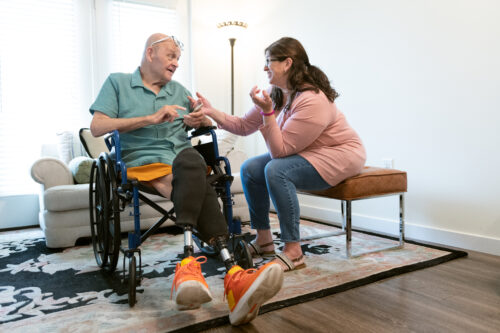Governor Newsom released his revised proposal for California’s fiscal year (FY) 2025-26 budget earlier this month. Amid soaring costs, lower-than-anticipated revenues, and turbulent market conditions, the state is now confronting a projected $12 billion shortfall in its General Fund (GF).1 To close the gap, the governor has put forward a comprehensive package—ranging from spending reductions and fund shifts to conditional budget commitments tied to future revenues. However, these proposals do not yet account for the potential impact of federal funding cuts currently under consideration in Congress.
While the proposed budget preserves some aging programs and services at baseline funding, it includes funding cuts that will reduce access to health care and Medi-Cal long-term services and supports (LTSS) for older adults and people with disabilities who are low-income, from communities of color, and/or rural dwelling. It also reverses course on key initiatives in the Master Plan for Aging (MPA) that began to address LTSS access and homelessness, such as the elimination of the Medi-Cal asset test limit and funding of the Home Safe program.
Proposed Cuts to Medi-Cal, IHSS, and More
The following is a breakdown from The SCAN Foundation of the proposed reductions that will affect older adults and people with disabilities.
Health Care
In recent years, California took steps to improve access to health care and LTSS for older adults and people with disabilities in alignment with MPA goals. This included elimination of the Medi-Cal asset test in 2024 for older adults and people with disabilities, the only Medi-Cal populations subjected to a monthly asset limit of $2,000/individual and $3,000/couple.2 Additionally, in 2022, Medi-Cal coverage was made available to all adults aged 50 and older that met income eligibility requirements.3 This included individuals with unsatisfactory immigration status (UIS), meaning they had undocumented status or “qualified” immigration status and were subject to the five-year restriction on accessing federal assistance programs (“five-year bar”). Proposals within the revised budget reverse these actions.

Long-Term Services and Supports
The proposed budget maintains current funding support for most LTSS programs, however, there are significant changes to In-Home Supportive Services (IHSS), California’s personal attendant program. IHSS serves approximately 840,000 recipients statewide.4 Providers are currently allowed to work up to 26 hours of overtime per week (for a total of 66 hours) and receive payment for up to 7 hours of travel. There are special exceptions, like allowing providers who live with and take care of multiple IHSS recipients, to work up to 90 hours a week.5
Additionally, there is the IHSS Residual (IHSS-R) Program, sometimes used as a grace period for someone who temporarily loses access to Medi-Cal (e.g., missing a paperwork deadline) to keep access to IHSS while eligibility issues are resolved.6 Proposals in the revised budget would impose more restrictive requirements limiting access to IHSS.

Food Security
California’s 2022-23 budget included funding to expand the California Food Assistance Program (CFAP) to adults age 55+ who are noncitizens, which will begin in October of 2027. The goal of CFAP is to provide state-funded food benefits to noncitizens who do not qualify for CalFresh, the state’s Supplemental Nutrition Assistance Program.7 The May Revise proposes a GF trigger to initiate the expansion in 2027.

Housing
Older adults are the fastest-growing segment of the homeless population in California, with many experiencing homelessness for the first time at age 50 or older.6 The May Revise excludes continued funding for the Home Safe program and Housing and Disability Advocacy Program (HDAP), the only state programs specifically focused on homelessness prevention for older adults and people with disabilities. Without the allocation of additional funding, Home Safe is scheduled to sunset by June 2026 and HDAP’s funding level will decrease, severely limiting the program’s reach.
What’s Next?
The legislature must now consider the May Revise and offer budget proposals of their own. They have until June 15 to pass a balanced budget, which the governor must sign or veto before July 1. The May Revise budget does not address the impact of proposed federal changes in development in Congress. It is possible that the governor may call a special session in the fall to respond to any federal changes that impact California’s budget.
References
- California Office of the Governor. (2025). May Revision 2025-26. Retrieved May 20, 2025, from https://ebudget.ca.gov/FullBudgetSummary.pdf.
- California Department of Health Care Services. (n.d.). Asset Limits. Retrieved May 20, 2025, from https://www.dhcs.ca.gov/Get-Medi-Cal/Pages/asset-limits.aspx.
- California Department of Health Care Services. (n.d.). Older Adult Expansion. Retrieved May 20, 2025 from https://www.dhcs.ca.gov/services/medi-cal/eligibility/Pages/OlderAdultExpansion.aspx.
- California Department of Social Services. (n.d.). In-Home Supportive Services (IHSS) Program Data. Retrieved May 20, 2025, from https://www.cdss.ca.gov/inforesources/ihss/program-data.
- California Department of Social Services. (n.d.). In-Home Supportive Services (IHSS) Exemptions for Provider Violations. Retrieved May 20, 2025, from https://www.cdss.ca.gov/inforesources/ihss-overtime-exemption-2.
- Bet Tzedek. (2017). Chapter 7: In-Home Supportive Services (IHSS). Retrieved May 20, 2025 from https://www.bettzedek.org/wp-content/uploads/2017/09/Chapter-7-IHSS-20174837-2664-5836.pdf.
- California Department of Social Services. (n.d.). CFAP Expansion. Retrieved May 20, 2025, from https://www.cdss.ca.gov/inforesources/cdss-programs/calfresh/cfap/cfap-expansion.
- Benioff Homelessness and Housing Initiative, University of California San Francisco. (2023). Toward a New Understanding: The California Statewide Study of People Experiencing Homelessness. Retrieved May 20, 2025 from https://homelessness.ucsf.edu/sites/default/files/2023-06/CASPEH_Report_62023.pdf.
Download a PDF of this budget analysis here.
